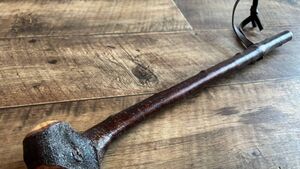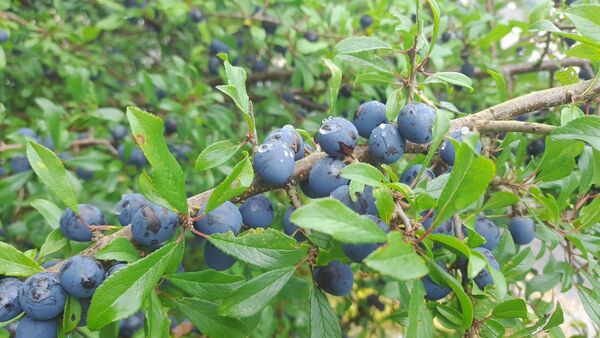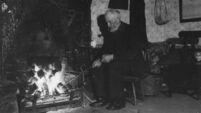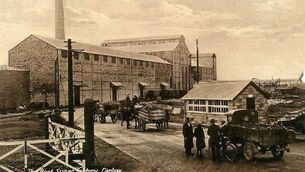Blackthorn sticks, shillelaghs and sloe gin

The shillelagh is typically made from a stout, knotty blackthorn stem with a large, heavy knob at the end.
My father used to tell a story about a man who was killed with a blow of a shillelagh in a fight at the Fair of Roscrea.
There was a subsequent trial about the incident but the accused got off scot-free. The judge, when justifying his verdict, is reputed to have said: “The evidence shows that the victim had an unusually thin skull and, in my opinion, the Fair of Roscrea was no place for a man with a thin scull.”
It must be said, regardless of how thick the man’s skull might have been, if he was hit with a shillelagh, he was hit with something that was hard enough and tough enough to do a lot of damage. In today's more enlightened times, the shillelagh is a thing of the past and is more often seen as a touristic souvenir than a weapon of choice for fair-goers.
Blackthorn, or sloe, is a native Irish shrub or small tree known for its dense, thorny branches, dark bark, and white flowers that appear before its leaves in early spring. Blackthorn wood is prized for its strength and durability. It is as supple as leather and as hard as steel.
The blackthorn produces small, sour, dark fruits called sloes, which can be used to make preserves, gin, and liqueurs, and provide food for wildlife. Blackthorn is a hardy, resilient plant, often found in hedges and scrubland, contributing to biodiversity and serving as a traditional symbol of hope and endurance.
Traditionally, a blackthorn stick is formed from the main stem of the blackthorn plant. It is a simple enough process once you find the right plant. The following description from an online gift shop describes the traditional blackthorn stick from a modern standpoint and makes the point that such a stick is a very versatile implement indeed.
Some people confuse the blackthorn stick and the shillelagh. They are not the same; one is a regular walking stick and the other is shorter and less unwieldy. The shillelagh is typically made from a stout, knotty blackthorn stem with a large, heavy knob at the end. In many respects, a shillelagh resembles a policeman’s truncheon - similar in length and weight. Indeed, the emergence of the truncheon was likely a progression of the trusty shillelagh.
The term "shillelagh" is believed to be derived from the village of Shillelagh in County Wicklow, which was known for its abundance of blackthorn and oak trees. Historically, the shillelagh was used as a tool, a weapon, and for self-defence. It was also central to the traditional Irish stick-fighting sport of Bataireacht, which was popular in the 18th and 19th centuries.
Bataireacht was a traditional Irish martial art, using weapons like the shillelagh. Bataireacht had associations with cultural identity, self-defence, and faction fights. Faction fighting in Ireland was a phenomenon primarily of the 18th and 19th centuries when, at that time, large, organised factions, often clan or parish based, would meet at gatherings like fairs and markets to engage in mass brawls.
These violent encounters, sometimes involving hundreds of people, resulted in serious injury, maiming, and even death - as the thin-skulled man in Roscrea soon found out. While sometimes rooted in local rivalries, these fights also served as a way for communities to express anti-establishment sentiments and were used by the authorities as a method to prevent unified resistance against the government of the day.
Among my father’s crafty pastimes was his passion for making blackthorn sticks. He always had a bunch of them left aside for use as gifts or for driving cattle. One of his great farm safety tips was to never go among cattle without a stick in hand.
His process involved carefully selecting the right plant; the bush needed to have a straight and reasonably lengthy stem - not that easy to find in a low bush. He would allow the leaves to fall before digging up the plant. This meant it was at maximum strength after the growing season but was also easier to access.
Initially, the plant was trimmed, root and branch, into the rough shape of the final product. At this point the piece was given time, allowing it to dry out and season. When seasoned, the finishing work took place. This meant cutting the branch stubs closer to the stem and the root ball was also trimmed to form a suitable hand crip. The new stick would then be straightened by shaping it over his knee if necessary. Eventually the blackthorn stick was fully formed. A little coat of varnish and a copper furl were his hallmark finishing touches.

The sloe is the small, dark purple-black, fruit of the blackthorn. While too bitter to eat raw, sloes are commonly used after the first frost to flavour drinks like gin and other spirits. They are also used for making jams, jellies, and syrups. Sloe gin is their most common use, with the fruit soaking in gin to create a sweet and tangy liqueur. Sloes are also used to make other spirits, such as the Spanish Patxaran (with an anise-flavoured spirit), the German Schlehenfeuer (using white rum), and the Italian Bargnolino (with sugar and spices).
The tartness of sloes can also be used in homemade jams and jellies after the initial bitterness is mellowed by frost or freezing. They are on the bushes at present so if you want to have a crack at getting some use out of them, knock yourself out. The following is a simple Sloe Gin recipe you might like to try. It includes just three basic elements: 500g ripe sloes, 250g golden caster sugar and one litre gin.
Method: rinse the sloes and dry in a clean tea towel. Using a cocktail stick, prick the sloes and tip into a two-litre glass jar. Add the sugar and gin, then seal the jar. Once a day for seven days, give the jar a good shake. Store the jar in a cool, dark place and leave for two to three months. Line a plastic sieve with a square of muslin set over a bowl and strain the sloe gin through it. Decant into clean, dry bottles, then seal and label. The sloe gin is now ready to drink but it improves over time. If possible, make it a year ahead.
About a year from now, just as winter is beginning to bite, take a stroll, blackthorn stick in hand. Wrap up against the chilly breeze and as you amble along, enjoy the delights of our landscape. After a few miles of road, return home to a warm fire and complete your Ox Mountain experience with a glass of your very own sloe gin.





